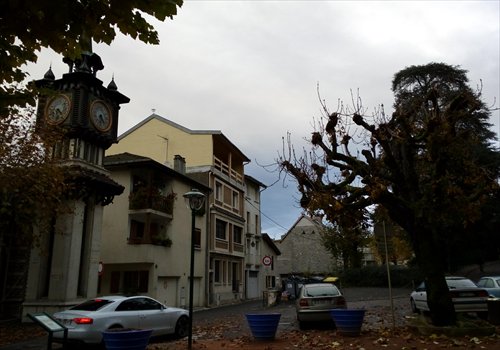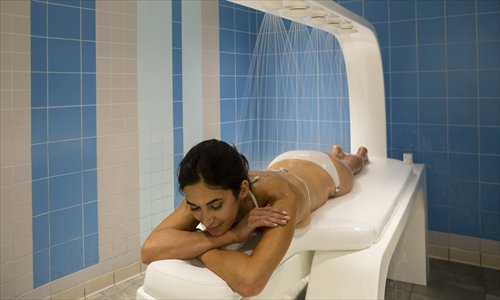HOME >> LIFE
A visit to the home of Evian bottled water
By Tiara Lin Source:Global Times Published: 2016-1-8 5:03:01

A view of Evian, France Photo: Tiara Lin
When my friends saw me buying a bottle of Evian, five times more expensive than Chinese bottled water, they pointed out that Evian spelled backwards is "naive.""Bottled water has become liquid gold," is how the Financial Times (FT) described Evian's marketing strategy that links bottled water with health and wellness.
Last month, I watched Italian comedy-drama film Youth, which was set in a luxurious spa resort in the Swiss Alps. As I watched veteran actor Michael Caine and Harvey Keitel discuss the meaning of life and death, youth and old age while enjoying massages, wraps and a sauna, the idea of visiting Evian, the birthplace of the famous bottled water, sudden hit me.
Are people from Evian really healthier because they drink this magical water every day? What is the unique source of this water and how does it live up to its slogan to "live young?"
My friends and I decided to take a day trip to Evian to look for the answers.
Birthplace of Evian water
Evian water is internationally well-known, but not many people know its birthplace. For a start, the town of Evian-les Bains, also known as Evian, is located on the edge of Europe's biggest lake: Lake Leman, also known as Lake Geneva, in the French Alps.
During a cold, grey morning in December, we took a ferry from the Swiss city of Lausanne. After a boring and depressing 30-minute ferry ride, we arrived at Quai Baron de Blonay, the main quay in Evian.
In summer, the town of Evian, normally home to some 8,000 residents, comes alive. Its population reaches nearly 50,000 as it attracts thousands of health-conscious visitors from all over the world, according to FT's report. While in winter, the town goes to sleep during the long nights and grey days. I barely saw 80 people during our day trip.
'Miraculous' water
The old town of Evian is really small. There is only a single road running in and out of it. You can pick up a walking map from the tourist office, or you can just wander around. It's hard to get lost.
It is said that every drop of Evian's water starts as rain or snow on the peaks of the Alps; it takes 15 years for that water to make its way to the spring. During those years, the water is filtered through a lot of layers of glacial land, which makes the water filtered naturally without the use of chemicals.
Evian's water was discovered back in 1790 by a French nobleman. It is said that after drinking this "miraculous" water, the man, who had liver and kidney problems, felt "refreshed." Since then, French doctors started sending their patients to try this healing water. In 1824, the first Evian Baths was established. Five years later, the first mineral water company was found to start bottling water from the spring. Even today the water plays a huge financial role, about 70 percent of local government revenue is related in some way to the water.
Inspired by the story, we went straight to visit the Evian exhibition hall to try the water there. It was a beautiful building with a giant semi-circular glass window. Unfortunately, the hall only opens from May to September. We also tried to visit the Evian bottling plant located outside town, at Amphion, to learn more about the history and geology of the town and see the latest designs by American fashion designer Alexander Wang. Unfortunately, the plant was closed this year.
The only consolation was the free water that was available to drink everywhere! A 500 milliliter bottle of Evian water costs €1.8 ($1.95) at a vending machine. But you can fill up your bottles with spring water at four different public fountains for free. I found myself wishing I had brought a bigger bottle.
As a budget traveler, I've always felt a bit ashamed when I would refill my used bottles. In Evian, however, this was not an issue. We saw severael locals bring large bottles that they refilled at the La Source Chachet, the original source of Evian water. They reminded me of my father, who worries about the quality of drinking water in China so much that he hikes all the way up to the top of the mountain near our home for water.
So what does the water in Evian taste like? I'm no water expert, but I can tell it's different from other brands. It doesn't have even a slight mineral taste. We asked the locals who come to refill the bottles if they drank Evian water every day.
"Well, I don't like drinking tap water. If I'm feeling too lazy to come here, I get it from the supermarket," a local told us.
Live young

A woman enjoys a spa treatment in Evian. Photo: Courtesy of Evian Tourist Office
Some 180 years ago, Evian opened its first spa center. Nowadays, Evian's resorts and spa treatments draw thousands of luxury travelers every year.Of course, everyone wishes they can stay young forever. I believe when the G8 summit was held here in Evian in 2003, the world leaders also wanted to take advantage of the water resources here. Maybe a massage, maybe a mud treatment or a beauty spa after meetings could help relax their minds so they may better run the world.
Moreover, Evian is only 45 kilometers away from Geneva, home to a United Nations office and over 250 international organizations and NGOs. I'm sure these elites need to kick back and relax from time to time.
Spa treatments vary from one hour to seven days. According to the Luxury Travel Bible, a website for luxury tourists, one of the most popular spa treatments is called "under the rain" - warm Evian water is showered down onto your back so you can relax "under the rain." Therapists work with water pressure to release the tension in the muscles. Moreover, just listening to the sound of the water can also be very relaxing. At the end of a session, of course, you get to enjoy a nice glass of Evian water and the stunning view of the lake.
However, there is a price to pay to live young. At a four-star hotel, an hour-long hot and cold stone spa treatment costs €120. My friends and I couldn't afford any treatments, but we were all aware of the benefits of drinking water. My friends and I sat in front of the fountain for an hour, just to make sure we drank enough Evian water to keep our skin hydrated through the rest of the day.
An Evian tale
Even though winter in Evian is not as lively as summer, if you come between December 11 and January 3, don't miss out on the annual year-end event known as the "Fabulous Village of the Legend of Flottins," during which you will be delighted by a little village of ghoulish wooden sculptures.
It starts with the fairy-folk. Since the beginning of time, fairy-folk of all kinds have washed up on the beach in Evian. They are carried along on their driftwood rafts. In the winter, some imaginary creatures called Flottins, the inhabitants of the village, would expand their village with these pieces of driftwood. One November, Santa Claus' reindeer made an emergency landing on Lake Geneva and was saved by the Flottins. Since then Santa Claus visits his Flottins friends before making his big annual Christmas trip.
In the cold winter daytime, the town was so quiet that I could clearly hear my footsteps as I walked. When the sun went down, hundreds of people seemed to erupt from the ground in groups to join the evening event. We had so much fun wandering through the Flottins village amongst scary-looking wooden sculptures on the "monster" street.
If you stay there overnight, you can definitely spend a scary Christmas with the magical creatures.
Rules of thumb:
Getting there:
From Switzerland, you can take a 30-minute ferry from Lausanne. From Paris, you can take a rapid TGV direct train on certain weekends. The nearest airport is located in Geneva, about 50 kilometers away.
What to do:
There is a farmer's market on Tuesday and Friday mornings from 8:30 to 12:30. Regional products include Savoy cheese, hams, cabbage sausages, fish and local wines such as Ripaille and Marin.
There are a wide variety of outdoor activities you can do in Evian: golfing, sailing, swimming, horse riding, hiking and fishing.
Source: Evian Tourist Office
Newspaper headline: Right to the source
Posted in: Feature